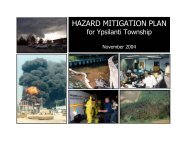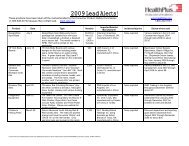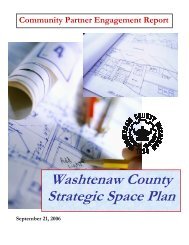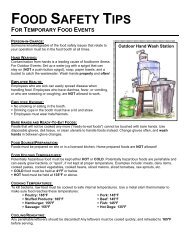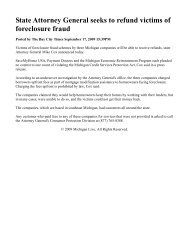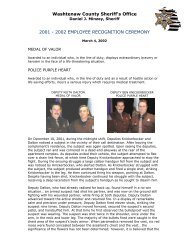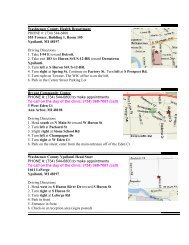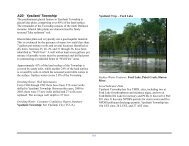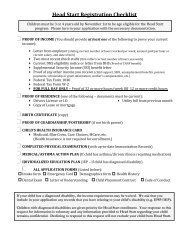Water Protection Activities in Washtenaw County
Water Protection Activities in Washtenaw County
Water Protection Activities in Washtenaw County
You also want an ePaper? Increase the reach of your titles
YUMPU automatically turns print PDFs into web optimized ePapers that Google loves.
<strong>Water</strong>shed Plan BMP Title BMP Description BMP Outcome<br />
Mill Creek Install and ma<strong>in</strong>ta<strong>in</strong> vegetated roofs<br />
Structural addition of plants/soil over a traditional roof<br />
system Improved energy efficiency, reduction of storm water runoff<br />
Mill Creek Implement private roads ord<strong>in</strong>ance Allows for roads to be narrower than county standards Reduction of impervious surface area m<strong>in</strong>imiz<strong>in</strong>g runoff to watershed<br />
Establish flow limits <strong>in</strong> storm water NPDES could/should limit flow for permit holders no<br />
Mill Creek<br />
permits<br />
limit is currently established Limits will reduce hydrology damage associated with excess flow<br />
Implement alternative dra<strong>in</strong> Look for opportunities to correct old dra<strong>in</strong>age practices<br />
Mill Creek<br />
practices and rehab<br />
like tiled agricultures Restores hydrologic function<br />
Implement stream bank stabilization Improve stream bank structurally through eng<strong>in</strong>eers, Improves stream health if flow and erosion issues are addressed prior<br />
Mill Creek<br />
measures<br />
bioeng<strong>in</strong>eered, or biotechnical stabilization<br />
Streamside ecosystems managed for the enhancement of<br />
to implementation<br />
Mill Creek Install and ma<strong>in</strong>ta<strong>in</strong> riparian buffers water quality Slower runoff velocities, <strong>in</strong>filtration, sediment and nutrient filtration<br />
Create and ma<strong>in</strong>ta<strong>in</strong> grassed Natural or constructed channels on farm lands established<br />
Mill Creek<br />
waterways<br />
with suitable vegetation<br />
Install structures to control the grade and head cutt<strong>in</strong>g <strong>in</strong><br />
Treatment of sheet flow, improved <strong>in</strong>filtration, reduced erosion<br />
Mill Creek Install grade stabilization culverts channels (mostly agricultural)<br />
Plant permanent vegetation cover on properties with<br />
Reduces erosion and sedimentation<br />
Mill Creek Utilize conservation cover<br />
exposed soil (primarily agricultural) Reduces soil/sediment run off and nutrient/nitrate issues/load<strong>in</strong>gs<br />
Practice crop rotation w/ cover and Employ agricultural techniques that limit impacts on<br />
Mill Creek<br />
mulch<br />
water quality Reduced sedimentation, and nutrient load<strong>in</strong>gs<br />
Install and ma<strong>in</strong>ta<strong>in</strong> sediment Barriers, bas<strong>in</strong>s and other devise designed to remove<br />
Mill Creek<br />
trapp<strong>in</strong>g devices<br />
sediment from runoff Reduction of sediment <strong>in</strong> storm water<br />
Install and ma<strong>in</strong>ta<strong>in</strong> catch bas<strong>in</strong> Installation of additional sump chambers to enhance<br />
Mill Creek<br />
<strong>in</strong>serts<br />
collection of solids Reduction of sediment <strong>in</strong> storm water<br />
Mill Creek Control soil erosion Stabilize slopes and soils Prevents or reduces erosion due to storm water run off.<br />
Mill Creek<br />
Mill Creek<br />
Mill Creek<br />
Construct and ma<strong>in</strong>ta<strong>in</strong> media/sand<br />
and organic filters<br />
High powered street and paved area<br />
sweep<strong>in</strong>g<br />
Repair misaligned/obstructed<br />
culverts<br />
Mill Creek Stabilize road/bridge surfaces<br />
Mill Creek Practice nutrient management<br />
Construct and ma<strong>in</strong>ta<strong>in</strong> waste<br />
Mill Creek<br />
storage facilities<br />
Mill Creek<br />
Mill Creek<br />
Install and ma<strong>in</strong>ta<strong>in</strong> livestock use<br />
exclusion<br />
Install and ma<strong>in</strong>ta<strong>in</strong> vegetated filter<br />
strips<br />
Construct variety of filters - usually two chambered sand<br />
or sand/peat mix Removes pollutants and particulates from storm water<br />
A management measure that <strong>in</strong>volves pavement clean<strong>in</strong>g<br />
on a regular basis Reduction of sediment debris and pollutant export to receiv<strong>in</strong>g waters<br />
Coord<strong>in</strong>ate townships and <strong>County</strong> efforts to address<br />
dra<strong>in</strong>age problems Addresses changes <strong>in</strong> hydrology and ma<strong>in</strong>tenance<br />
Alter grad<strong>in</strong>g practices and exam<strong>in</strong>e surface options on<br />
unpaved roads and bridges Reduce sediment pollution<br />
Employ Generally Accepted Agricultural Management<br />
Practices (GAAMPs) on agricultural land<br />
Construct barriers, embankments, and temporary waste<br />
storage facilities for agricultural uses<br />
Construct barriers like fences to keep livestock 25 feet<br />
from banks<br />
Strips of grass or other permanent vegetation designed to<br />
treat sheet flow<br />
146<br />
Controls or limits potential pollutant/nutrient exposures from<br />
agricultural land use<br />
Reduces exposure pathways prior to land application of<br />
nutrients/fertilizers<br />
Protects riparian vegetation and banks from animals, limits waste<br />
exposure pathways<br />
Slower runoff velocities, better <strong>in</strong>filtration, sediment and nutrient<br />
filtration



